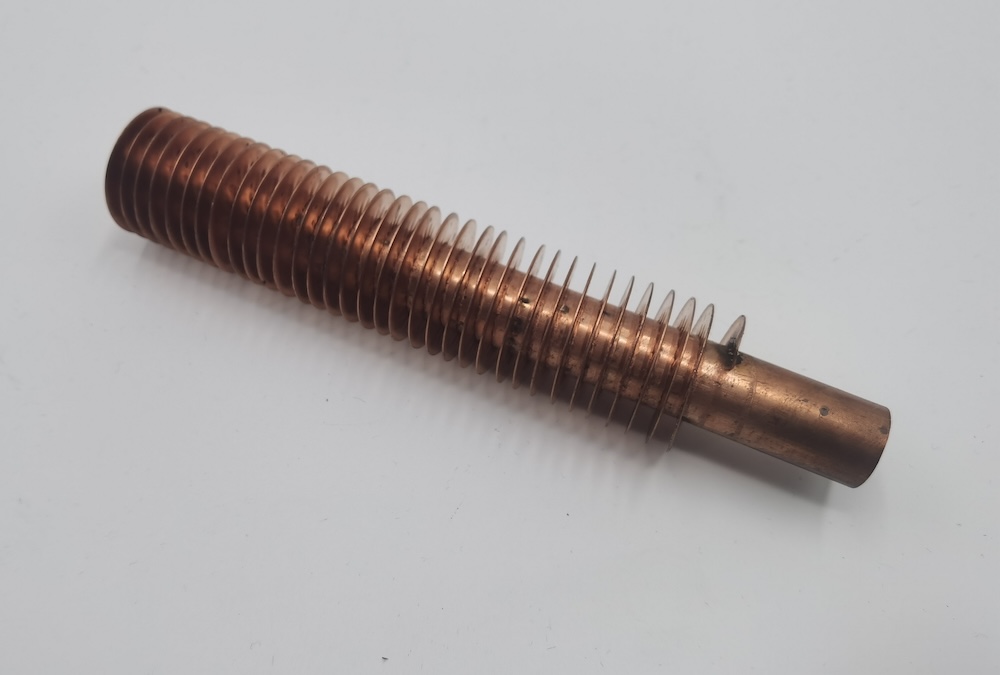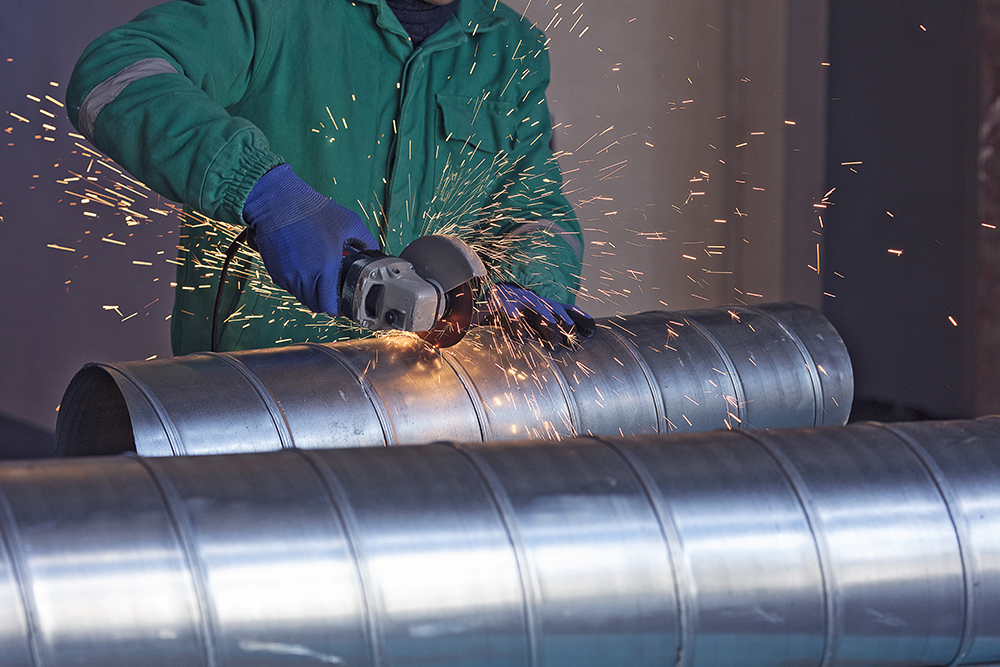Copper fin tubes are widely used in heat exchange systems due to copper’s excellent thermal conductivity, corrosion resistance, and durability. When it comes to choosing between extruded and welded copper fin tubes, it’s essential to understand the differences in design, performance, and application suitability. This guide will explore the advantages of each type, helping you decide which is the best option for your needs.
“Extruded copper fin tubes have a single-piece design that enhances durability and efficiency, while welded copper fin tubes offer flexibility and lower production costs. The choice depends on the application’s requirements for heat transfer, durability, and budget.” Knowing the differences helps in making an informed decision that optimizes system performance.
What is an Extruded Copper Fin Tube?
An extruded copper fin tube is made by forming fins directly from the outer surface of a single copper tube, creating an integrated, one-piece structure. In this process, a thicker copper tube is fed through a machine that compresses and stretches the material, forming fins as an extension of the tube itself. This unique manufacturing process results in a highly durable fin tube that has seamless thermal conductivity.
Key Characteristics of Extruded Copper Fin Tubes
- Seamless One-Piece Design: The fins and tube are a single unit, which enhances durability and improves heat transfer performance.
- High Thermal Conductivity: Because the fins are part of the copper tube, thermal conductivity is seamless, allowing for efficient heat transfer.
- Corrosion Resistance: With no joints or seams, extruded fin tubes are resistant to corrosion, making them well-suited for outdoor or corrosive environments.
Extruded copper fin tubes are widely used in high-demand applications like HVAC systems, power plants, and industrial heat exchangers, where performance and durability are priorities. Below photo you can see our Cufin Tube’s extruded fin tube sample, very clean and beautiful.
What is a Welded Copper Fin Tube?
A welded copper fin tube is manufactured by attaching copper or aluminum fins onto the tube through welding. In this process, the fins are added to the outer surface of the copper tube and securely welded to ensure a tight bond. Welded fin tubes offer flexibility in design, as the fin shape, thickness, and density can be adjusted based on specific application requirements.
Key Characteristics of Welded Copper Fin Tubes
- Flexible Design Options: Welding allows for a variety of fin shapes, densities, and thicknesses, making welded fin tubes adaptable to different applications.
- Lower Production Costs: Compared to extruded fin tubes, welded fin tubes are typically more affordable to manufacture, making them a budget-friendly choice.
- Good Heat Transfer: While not as seamless as extruded tubes, welded fin tubes still offer efficient heat transfer, suitable for many heating and cooling applications.
Welded copper fin tubes are often used in applications where cost and customization are essential, such as in commercial HVAC systems, automotive radiators, and smaller heat exchangers.
Comparing Heat Transfer Efficiency
Heat transfer efficiency is one of the most critical factors when choosing between extruded and welded copper fin tubes.
Extruded Copper Fin Tubes
- Superior Conductivity: The seamless connection between the fins and the tube in extruded designs ensures that heat flows directly from the tube to the fins without any interruptions, maximizing thermal efficiency.
- Optimal for High-Demand Applications: Extruded fin tubes are excellent in applications requiring continuous and high levels of heat exchange, as they maintain consistent thermal performance even under intense use.
Welded Copper Fin Tubes
- Good, But Slightly Lower Efficiency: The weld joints create a small barrier to heat transfer between the tube and fins, resulting in slightly lower efficiency compared to extruded fin tubes. However, welded tubes are still effective in moderate heating or cooling applications.
- Sufficient for Cost-Sensitive Applications: Welded fin tubes offer an acceptable level of heat transfer in systems where budget constraints are a priority, and extreme efficiency is not required.
For applications that demand the highest possible heat transfer efficiency, extruded copper fin tubes are generally the better choice, as their design allows for superior conductivity.
Durability and Resistance to Corrosion
The durability and corrosion resistance of fin tubes directly impact their longevity, especially in environments with high moisture, corrosive substances, or frequent temperature changes.
Extruded Copper Fin Tubes
- High Durability: Since the fins are part of the tube, extruded copper fin tubes have no seams or joints, which reduces the risk of corrosion or wear over time. This makes them particularly durable and ideal for outdoor or industrial environments.
- Superior Corrosion Resistance: The one-piece structure of extruded fin tubes prevents the buildup of rust or other corrosive elements at connection points, enhancing their longevity in challenging environments.
Welded Copper Fin Tubes
- Moderate Durability: Welded fin tubes are durable but may be more prone to corrosion at the weld joints. The separate fins create small gaps where moisture and contaminants can potentially accumulate, increasing the risk of corrosion over time.
- Good for Indoor or Controlled Environments: Welded copper fin tubes perform well in indoor or less corrosive environments where exposure to moisture and chemicals is limited.
For applications that require high durability and corrosion resistance, such as in power plants or coastal HVAC systems, extruded fin tubes are often preferred due to their seamless construction.
Cost Considerations
Cost is a significant factor in selecting fin tubes, as the manufacturing processes for extruded and welded tubes vary in expense.
Extruded Copper Fin Tubes
- Higher Manufacturing Costs: The extrusion process is more complex and involves higher material costs, making extruded fin tubes more expensive. However, the higher cost is often justified by the increased durability and efficiency.
- Long-Term Investment: Extruded fin tubes may have a higher upfront cost, but they offer a longer lifespan and reduced maintenance, potentially saving costs over time in high-demand applications.
Welded Copper Fin Tubes
- Cost-Effective Option: Welded copper fin tubes are generally less expensive to produce than extruded fin tubes, making them a good choice for budget-conscious projects.
- Ideal for Low to Moderate Demands: For applications that don’t require extreme durability, welded fin tubes offer a balance between performance and affordability.
For budget-sensitive projects, welded copper fin tubes are often the preferred choice due to their lower production costs, while extruded fin tubes are a better investment for long-term performance.
Application Suitability: Which Type is Better?
Choosing the right fin tube type depends largely on the specific application and operating conditions.
Extruded Copper Fin Tubes
- Ideal for High-Performance Needs: Extruded fin tubes are best for applications that require high efficiency and durability, such as industrial heat exchangers, power plants, and systems exposed to harsh weather or corrosive environments.
- Recommended for Continuous Use: In settings where the heat exchanger operates continuously, the seamless connection and durability of extruded fin tubes support long-term, reliable performance.
Welded Copper Fin Tubes
- Best for Moderate Applications: Welded fin tubes work well in applications with moderate heating and cooling demands, like commercial HVAC systems and automotive radiators.
- Suitable for Budget-Conscious Projects: In cases where the upfront budget is limited, welded fin tubes offer a cost-effective solution with good performance.
For high-performance applications, extruded copper fin tubes are often the superior choice due to their efficiency and longevity. Welded copper fin tubes, however, provide an affordable and customizable option for moderate demands.
Final Thoughts
When deciding between extruded copper fin tubes and welded copper fin tubes, it’s essential to consider the unique requirements of your application. Extruded copper fin tubes provide a seamless, one-piece design with higher thermal efficiency and durability, making them ideal for high-demand, long-term applications. Welded copper fin tubes, on the other hand, offer flexibility and affordability, making them suitable for moderate, budget-sensitive applications.
Summary: Extruded copper fin tubes offer better heat transfer and durability due to their seamless design, while welded copper fin tubes are more affordable and versatile. Choosing the right type depends on application needs, budget, and performance expectations.
Selecting the right fin tube design can optimize heat transfer efficiency, reduce maintenance, and improve system longevity, ultimately resulting in a heat exchanger that performs well and meets your specific requirements.










